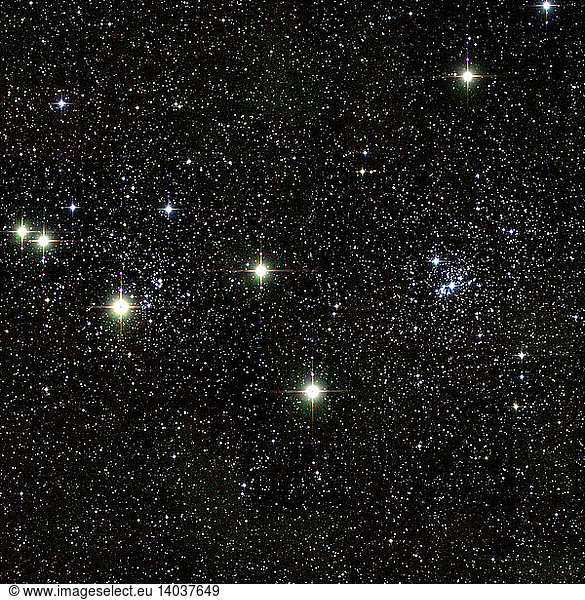Ah,
the Double Cluster in Perseus!
The Double Cluster in Perseus. Photo: Jack Groves.
Me being me, I prefer Roth Ritter's image at right, because the bright B-type stars in NGC 869 (at top in Jack Groves' image, at right in Roth Ritter's image) and NGC 884 look bluish in his picture. And these stars really
are bluish, but admittedly they are reddened by 7,500 light-years of dust. So it's not wrong to show them as all white as Jack Groves has done, but it's not wrong to show them as bluish, either.
The Double Cluster is a unique pair of clusters in the Milky Way, as far as I know. There is no other known example in our galaxy of two really giant young clusters that are so similar in mass, so perfectly similar in age and so close together in space. NGC 869 and NGC 884 are both 12.8 million years old, according to Wikipedia.That means that they are really young, but not young enough to be babies or toddlers, and they have lost their O-type stars. (So you may think of them as a pair of really strapping 12-year-old twin boys or twin girls, why not?)
You have to wonder what forces conspired to create two such amazingly rich and massive clusters in such close proximity, all in one go!

Anyway. Can't keep this from you.

Cassiopeia wide field. Image: Tom Wildoner.
Look at the picture at left. Can you guess what it is? It looks a little bit like the "W" in Cassiopeia, doesn't it? We can see a number of individual bright stars in a vaguely W-shaped configuration, and something that looks like a background cluster is visible at right. It is not too unlike Cassiopeia. By the way, don't miss the Double Cluster at lower left in Tom Wildoner's image at right.
Okay. What you are seeing in the picture at left is the Double Cluster in infrared. The individual bright stars are the red supergiants scattered around NGC 884. The seeming little "cluster" at right is NGC 869, which does not contain any red supergiants.
This is what the Double Cluster will look like when the James Webb telescope is looking at it!!!

Ann
 The Double Cluster in Perseus
The Double Cluster in Perseus

